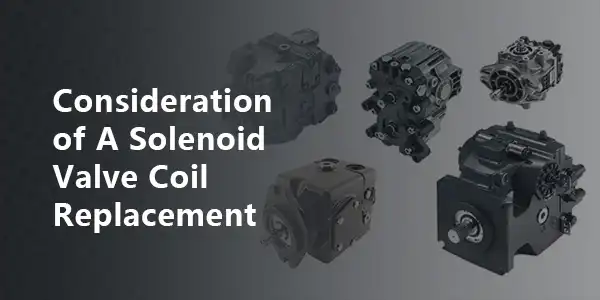Consideration of A Solenoid Valve Coil Replacement
The Importance of Replacing Solenoid Valve Coils
In excavators and heavy equipment, solenoid valve coils are a critical component of the hydraulic system. However, due to long periods of high-load operation and harsh working environments, coils may experience wear and tear and failure. Therefore, regular consideration of solenoid valve coil replacement is an important measure to ensure stable operation and prolong equipment life.
Coil life and wear:
Solenoid valve coils are subjected to constant operating stress in excavators and heavy equipment. Long periods of high load operation and frequent duty cycles can lead to coil wear and deterioration. The electrical performance of the coil may deteriorate over time, affecting the stability and responsiveness of the hydraulic system.
Effects of Coil Failure:
Failure of the solenoid valve coil may result in abnormal operation or stoppage of the hydraulic system. Failure of the coil may cause the valve to fail to open or close, affecting the hydraulic control and action of the equipment. This affects the proper functioning of the engine starter motor as well as the operational efficiency and safety of the equipment and can lead to equipment failure and damage.
Benefits of replacing coils:
Regularly replacing solenoid valve coils helps ensure proper operation and efficient performance of your hydraulic system. A new coil will provide faster response times and more consistent hydraulic control, resulting in smoother and more precise operation of the equipment. In addition, replacing coils extends the life of your equipment, reduces maintenance and downtime, and improves the productivity and economy of your equipment.
Influencing factors and maintenance strategies
1.Working Environment Factors:
Excavators and heavy equipment often operate in harsh working environments, such as construction sites and mining sites. These environments contain a large amount of dust, moisture and particulate matter, which may erode the surface of the solenoid valve coil, affecting the insulation of the coil and leading to coil failure.
Maintenance Strategy:
Regularly clean the solenoid valve coil and surrounding area to ensure that there is no accumulation of dust and impurities.
Where possible, take protective measures such as installing a shield or isolating the coil area to minimize the effects of the external environment on the coil.
2.Electrical Issues:
The operation of the solenoid valve coil is closely related to the electrical system. Electrical problems, whether 24 volt or 12 volt solenoid valve coil overvoltage, overcurrent, or voltage instability, can lead to coil damage or overloading, which can lead to coil failure.
Maintenance Strategies:
Regularly check the stability and operating condition of the electrical system to ensure that the solenoid valve coil is operating within normal electrical parameters.
Use suitable electrical protection devices, such as overload protectors and voltage stabilizers, to safeguard the coil from unstable current or voltage.
3.Frequent start-stop and work cycles:
Excavators and heavy equipment may require frequent start-stop and duty cycles during operation, placing high demands on the solenoid valve coil. Frequent starts and stops may result in increased coil temperatures and wear, affecting coil life.
Maintenance Strategy:
Where possible, use energy-saving controls and work optimization to reduce the number of frequent starts and stops and reduce the work load on the coil.
Periodically check the temperature of the solenoid valve coil to ensure that the coil is operating within the acceptable temperature range.
Coil Replacement Steps and Tips
Preparation:
Before beginning coil replacement, ensure adequate preparation. First, turn off power to the unit and safely isolate it. Check the maintenance manual or coil replacement guide provided by the equipment manufacturer for the replacement process and tools required.
Remove the original coil:
First, remove the diesel solenoid valve external protective cover and cable connections. Then, remove the original coil using appropriate tools, taking care to avoid damaging other parts. For older coils, care may be required to protect deteriorated connectors and connections.
Cleaning and inspection:
Before installing a new coil, clean and inspect the surface of the solenoid valve. Remove dust and dirt and make sure the coil mounting area is clean. Inspect the valve body and connectors for damage or abnormalities.
Installing the new coil:
Properly install the new coil onto the solenoid valve. Secure the coil to the valve body according to the equipment manufacturer's guidelines and make sure that the connecting wires are properly connected without crossing or misalignment. Use proper torque tools for tightening to avoid over-tightening or over-loosening.
Connecting Cables:
Connect the cables to the coil, ensuring that the joints are secure and not loose. Read the electrical connection instructions carefully to ensure proper connection and avoid wiring errors.
Action Test:
After completing the coil replacement, perform a solenoid valve test to verify the function of the coil. Turn on the power of the equipment and perform a simple test run to ensure that the solenoid valve operates normally and that there are no abnormalities in the hydraulic system.
In today's highly competitive engineering field, equipment reliability and efficiency have become especially important. By keeping an eye on the health of solenoid valve coils and replacing and maintaining them in a timely manner, we can guarantee the long-term stable operation of our equipment, reduce the frequency of downtime for repairs, and increase the service life of our equipment, thus maximizing the success and efficiency of our engineering projects.
 Track Your Order
Track Your Order




